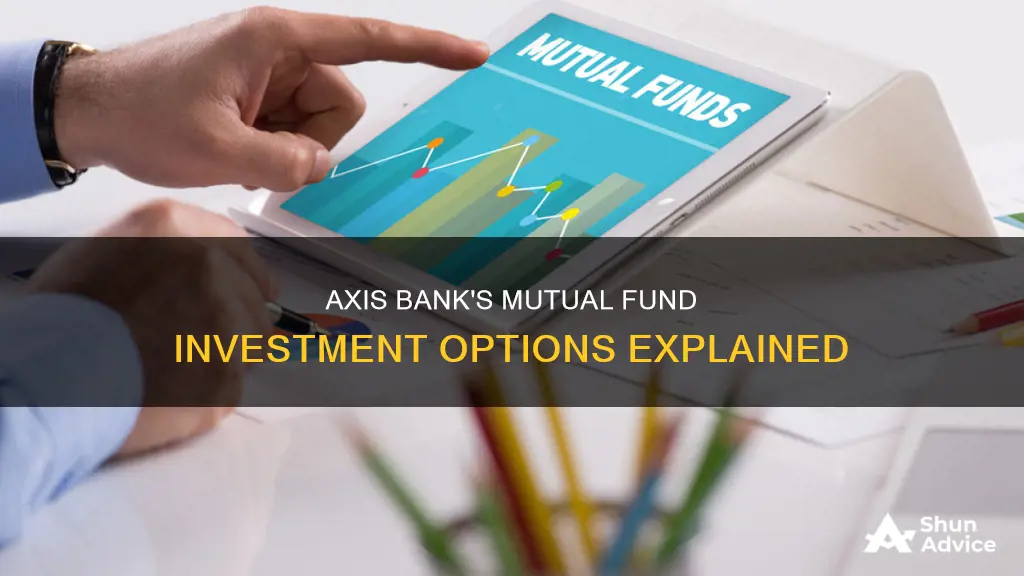
Axis Bank offers a range of mutual fund investment options to its customers, allowing them to invest in top-performing mutual funds across different categories such as tax-saving funds, long-term wealth creation funds, and balanced funds. These investment options provide customers with the opportunity to diversify their investments across different asset classes, such as equity, debt, and gold. Axis Bank's mutual fund offerings are managed by professional experts, aiming to provide inflation-beating and tax-efficient returns. The bank has partnered with several Asset Management Companies (AMCs) to provide a diverse range of schemes to its customers. The application process for Axis Bank mutual funds can be done online or offline, with the prerequisite of being a KYC-compliant Axis Bank account holder.
| Characteristics | Values |
|---|---|
| AMC Incorporation Date | October 2009 |
| Trustee organisation | Axis Mutual Fund Trustee Limited |
| Trustees | Mr. Radhakrishnan Nair, Mrs. Vijayalakshmi Iyer, Mr. G. Gopalakrishna, Mr. Venkat Chalasani |
| Investor Service Officer | Mr. Milind Vengurlekar |
| Total AUM (as of end of last quarter) | Rs. 2.74 lakh crores |
| Number of investment teams | 31 |
| Number of nations investment teams operate in | 19 |
| Number of cities present in | 100 |
| Number of active investor accounts | 98 lakh |
| Number of different schemes | 53 |
| Number of fund managers | 7 |
What You'll Learn

Types of mutual funds offered by Axis Bank
Axis Bank offers a range of mutual funds to its customers, allowing them to choose based on their investment goals and tenure. Here is a detailed look at the types of mutual funds offered by Axis Bank:
- Structure-based Funds: These can be close-ended or open-ended funds. Close-ended funds have a specified tenor and fixed maturity date, and investors can only buy fund units during the initial offer period. Open-ended funds, on the other hand, allow investors to buy and sell units at any time and have no maturity date.
- Equity Funds: These funds invest in equity instruments such as shares and are considered high-risk, high-return investments. They include large-cap, mid-cap, small-cap, and multi-cap funds, offering varying levels of investment risk.
- Debt Funds: Debt funds invest in fixed-income instruments such as corporate bonds, government bonds, and money market instruments. They are moderate-to-low-risk funds and include options like liquid funds, gilt funds, income funds, and corporate bond funds.
- Hybrid Funds: These funds invest in a combination of equity and debt instruments, offering a balance between risk and return. Balanced funds are the most popular type of hybrid fund, investing in both equities and debt.
- Tax Saving Funds: These funds, such as Equity Linked Savings Schemes (ELSS), offer tax benefits under Section 80C of the Income Tax Act, 1961, while also helping investors grow their money.
- Index Funds/Exchange-Traded Funds (ETFs): These funds are passively managed, meaning the fund manager invests in stocks that track and mimic a particular market index, such as NIFTY 50 or BSE SENSEX.
- Growth Funds: These funds aim for the appreciation of the money invested over medium to long-term periods. They invest a significant portion of the fund portfolio in equities, offering potentially high returns but with higher risk.
- Income Funds: The aim of income funds is to provide regular and steady income to investors. They invest in fixed-income securities, such as bonds, corporate debentures, and government securities, offering lower risk compared to equity schemes.
- Balanced Schemes: These funds strike a balance between risk and return by investing in both equities and debt. They have lower risk than equity or growth funds but higher returns than debt or fixed-income funds.
- Equity Diversified Funds: These funds invest in stocks across sectors and market capitalisations. They are considered high-risk, high-return funds.
- Large, Mid, and Small Cap Funds: Large-cap funds invest mainly in well-established companies with high market capitalisation, while mid-cap funds focus on mid-sized companies, and small-cap funds invest in smaller companies with high growth potential but higher risk.
- Gilt Funds: These debt funds invest only in government securities, offering a low risk of default.
- Corporate Bond Funds: These funds invest in corporate bonds and debentures, offering relatively higher interest but also higher volatility and credit risk.
- Money Market or Liquid Funds: These funds invest in short-term debt instruments issued by governments, corporates, or banks. They are highly liquid and low-risk.
- Hybrid Asset Allocation Funds: These schemes invest in a mix of equity, debt, and arbitrage, with the fund manager allocating resources based on the expected performance of each asset class.
- Capital Protected Schemes: These close-ended schemes are designed to ensure that investors get their principal back, regardless of market performance. They often invest in zero-coupon government securities.
- Arbitrage Funds: Arbitrage funds take opposing positions in different markets or securities to neutralise risk while earning a return.
- Equity Linked Savings Scheme (ELSS): ELSS is an equity-oriented mutual fund that offers tax savings and wealth creation. It has a lock-in period of 3 years, allowing the fund manager to take a long-term view and generate optimal returns.
- Specialty and Thematic Funds: Specialty funds invest in a specific sector, industry, region, or security type, while thematic funds follow an investment theme, such as infrastructure or telecom. These funds are often considered riskier due to a lack of diversification.
A Guide to Index Fund Investing in Australia
You may want to see also

Benefits of investing in mutual funds
Investing in mutual funds can be highly beneficial for your financial goals. Here are some advantages of investing in mutual funds:
Diversification of Investments
Mutual funds allow you to diversify your investments by investing in different asset classes such as equity, debt, and gold. Not all asset classes perform well at the same time, so diversifying your investments can help reduce risk and provide more stable returns.
Freedom to Choose Amount and Frequency
Mutual funds give you the freedom to decide how much you want to invest and when you want to invest. While some funds have a minimum investment amount, there is usually no upper limit. You can invest any amount at any time, either as a lump sum or in regular monthly instalments through Systematic Investment Plans (SIPs). This flexibility makes it easy to invest according to your financial goals and risk tolerance.
Easy to Track
Mutual fund houses provide regular updates about the fund's performance, making it easy to keep track of your investments. You can also access all the details about your investments through the Axis Mobile App or Axis Internet Banking, allowing you to monitor your investments on-the-go.
Expert Fund Management
The money invested in mutual funds is managed by experts or fund managers. These professionals have an in-depth understanding of the markets, companies, and sectors. They use their experience and analytical skills to make critical decisions about investing in stocks and other asset classes, aiming to optimise returns.
Convenience and Discipline
Investing through SIPs offers a convenient and disciplined approach to investing. Once you set up a SIP, a fixed amount is automatically deducted from your savings account at regular intervals and invested in the chosen mutual fund scheme. This helps you stay invested regardless of market conditions and benefits from rupee cost averaging.
Power of Compounding
Mutual funds offer the potential for higher returns through the power of compounding. When you reinvest the returns earned on your principal investment, your new principal amount grows, and you earn returns on this larger amount. Over time, this process can lead to significant wealth accumulation.
Mutual Funds: Best Time to Invest for Maximum Returns
You may want to see also

How to invest in mutual funds
Before investing in mutual funds, it is important to understand what they are and how they work. Mutual funds are investment schemes where money from multiple investors is pooled and invested in market-linked instruments by a fund manager. The value of the investment fluctuates with the market, and investors can redeem their units at any time.
Identify your goals:
Align your mutual fund investment with your financial objectives and investment horizon. This will help you determine how much wealth you need to accumulate and over what period of time.
Know the types of mutual funds:
There are various types of mutual funds, including equity funds, debt funds, hybrid funds, tax-saving funds, and more. Choose the type of fund that suits your risk appetite, investment goals, and time horizon.
Fulfil Know Your Customer (KYC) requirements:
Complete your KYC verification and documentation, which is mandatory for all investors according to SEBI guidelines. This can be done through a KYC Registration Agency (KRA) registered with SEBI, and you can check your KYC status on their websites.
Note all risk factors:
Be aware of the risks associated with mutual fund investments. Choose funds that match your risk profile, and avoid high-risk funds if you are not comfortable with potential losses.
Choose a fund house:
Select a reputed and experienced fund house or asset management company (AMC) that has a good track record of handling market fluctuations and making strategic investment decisions.
Set up a Systematic Investment Plan (SIP):
SIP allows you to invest small amounts regularly, providing a disciplined approach to investing. You can start with a low amount, such as Rs. 500, and increase it as your income grows or as you become more comfortable with market-linked investments.
Choose a plan:
Consider factors such as past performance, investment goals, and risk appetite when selecting a mutual fund plan. There are plans tailored to specific goals, such as retirement or children's education.
Understand tax implications:
Profits from mutual fund investments are taxed as capital gains, which can be short-term (held for less than 36 months) or long-term (held for more than 36 months). The tax rates vary depending on the type of mutual fund and the duration of investment.
Make your investment:
You can invest in mutual funds online or offline. When investing online, you will need to register and create an account, provide identity and address proof, choose your investment duration and risk level, and select the specific mutual fund.
By following these steps, you can invest in mutual funds and work towards achieving your financial goals. Remember to stay informed, make decisions aligned with your goals and risk profile, and regularly review your investments.
Emergency Fund Strategies: Where to Invest for Peace of Mind
You may want to see also

Tax implications of mutual funds
Mutual funds are taxed as per long-term capital gains (LTCG) and short-term capital gains (STCG). These are profits made on the sale of the units of an investment held for a long-term (more than 36 months) or a short-term (less than 36 months). The LTCG tax rate is 10%, while the STCG tax rate is as per the existing income tax slabs.
Mutual funds like Equity Linked Savings Schemes (ELSS) are eligible for tax benefits under Section 80C of the Income Tax Act, 1961.
When you invest in equity funds, the investment will attract a flat tax rate of 15% along with a 12% surcharge and 4% cess if the holding period is less than one year. This tax is known as the short-term capital gains tax. Since April 2018, long-term capital gains (LTCG) on equity funds are taxed at the rate of 10% along with a 12% surcharge and 4% cess. There is a basic exemption limit of Rs. 1 lakh available beyond which the LTCG will be taxed without indexation.
In debt fund investments, the short-term capital gains will be taxed on investments held for less than 3 years and as per your income tax slab. The tax rate for the highest bracket will be 30.9%. The long-term capital gains on debt funds attract a tax of 20% along with a 12% surcharge and 4% cess with indexation.
The taxation rate of capital gains of mutual funds depends on the holding period and type of mutual fund. Capital gains realised on selling units of mutual funds are categorised as follows:
- Short-term capital gains
- Long-term capital gains
- Shorter than 12 months
- 12 months and longer
The short-term and long-term capital gains offered by mutual funds are taxed at different rates.
The taxation of mutual funds depends on the holding period. However, if the debt mutual funds, i.e. the mutual funds with investment less than 35% of its proceeds in equity shares of a domestic company, will be considered short-term irrespective of the holding period. This is applicable only if the debt mutual funds are purchased after 31 March 2023.
The Securities Transaction Tax (STT) is separate from the Capital Gains and Dividend Taxes. When you buy or sell Mutual Fund units of an Equity Fund or a Hybrid Equity-Oriented Fund, the government (Ministry of Finance) will assess an STT of 0.001%. On the other hand, the sale of Debt Fund units is exempt from STT.
Taxation of Dividends Offered by Mutual Funds
As per the amendments made in the Union Budget 2020, dividends offered by any mutual fund scheme are taxed in the classical manner. That is, dividends received by investors are added to their taxable income and taxed at their respective income tax slab rates.
Previously, dividends were tax-free as the companies paid dividend distribution tax (DDT) before paying dividends.
The Mutual Fund scheme's dividend is also subject to TDS (tax deducted at source). The AMC is now required to deduct 10% TDS under Section 194K from the dividend that the Mutual Fund distributes to its investors when the rules have changed if the total dividend paid to an investor during a financial year exceeds ₹5,000. You can claim the 10% TDS that the AMC has already taken out when you pay your taxes and only pay the remaining amount.
Taxation of Capital Gains Offered by Mutual Funds
The holding period and type of Mutual Funds affect the tax rate on capital gains for Mutual Funds. The holding period is the time an investor holds units of a mutual fund. Put simply, the holding period is the time between the date of buying and selling Mutual Funds units.
The following categories apply to capital gains realised on the sale of Mutual Fund units:
- Indian Equity Funds/ETFs & Equity-oriented hybrids – 15% (if held for less than 1 year); 20% (if held for less than 1 year); 10% (on gains above Rs 1 lakh if held for over 1 year); 12.5% (on gains above Rs 1.25 lakh if held for over 1 year)
- Debt funds/ETF & debt-oriented hybrids – Slab rate if held for less than 2 years; 12.5% if held for over 2 years
- All FOFs (that hold less than 65% in debt)/International/gold funds/ETFs – Slab rate if held for less than 2 years; 12.5% if held for over 2 years
- Investments made before April 1, 2023, will attract a 12.5% tax if sold after 2 years.
New rule applies from April 1, 2025. Redemptions made before will be taxed at your slab rate.
Taxation of Capital Gains Provided by Equity Funds
Mutual Funds classified as equity funds have an equity exposure of at least 65%. As previously stated, when you redeem your equity fund units within a holding period of one year, you realise short-term capital gains.
When you sell your equity fund units after holding them for at least a year, you realise long-term capital gains. These capital gains are tax-free, up to Rs 1.25 lakh per year.
Any long-term capital gains over this threshold are subject to a 12.5% LTCG tax, with no benefit of indexation.
Taxation of Capital Gains Provided by Debt Funds
Debt mutual funds have entirely different taxation. If a debt investment is sold within 3 years, it will be deemed STCG. This STCG will be added to the income of the investor and would be liable to be taxed according to the tax slab under which the investor falls.
If debt investments have a holding period of more than 3 years, they will be termed LTCG. They will attract an LTCG tax as per the individual's tax slab rate with no indexation benefits.
Note: Indexation applies only to LTCG that's earned on non-equity-oriented mutual funds.
Another important thing to note is that the fund manager will levy an STT of 0.001% if you plan to sell your equity fund units. STT does not apply to the sale of units in debt funds.
It is essential to remember that debt funds no longer have the benefit of LTCG. The capital gains that arise from such funds will be liable to be taxed according to the tax slab rate under which an investor falls.
Blackstone Energy Fund: A Guide to Investing in Their Success
You may want to see also

Mutual fund fees and charges
When investing in mutual funds, there are several fees and charges to be aware of. Here is a detailed overview of the various fees and charges associated with mutual fund investment plans:
- Exit Load: An exit load is a fee charged when an investor chooses to exit a mutual fund investment before the completion of the investment tenure. The fee is designed to encourage investors to remain invested for a longer period. The amount of the exit load varies depending on the holding period and the guidelines of the specific fund house.
- Expense Ratio: The expense ratio represents the percentage of average assets under management that are used to cover administrative, fund management, and distribution expenses incurred by the Asset Management Companies (AMCs). It is calculated by dividing the operating and management fees by the total fund value. The expense ratio is included in the Net Asset Value (NAV), so investors do not have to pay these charges separately. However, it is important to note that the expense ratio can differ from fund to fund, with passively managed funds typically having lower expense ratios than actively managed funds.
- Stamp Duty: Introduced in July 2020, stamp duty is a direct tax levied by the government on the issuance and transfer of mutual funds. The rate of 0.005% is applicable for purchases, fresh instalments in existing SIPs and STPs, switch-in, and dividend reinvestment transactions. For transfers between demat accounts and off-market transfers, the rate is 0.015%. Stamp duty is deducted from the net investment amount, and the units are allotted accordingly. It is important to note that stamp duty is not applicable during the redemption of units.
- Securities Transaction Tax (STT): When investors decide to sell their mutual fund units, they are subject to STT. For close-ended schemes and ETFs, the STT is 0.001% of the traded value, while for open-ended equity-oriented schemes, it is 0.25% of the traded value. No STT is levied on the sale of debt mutual fund units.
It is important to carefully consider these fees and charges when making investment decisions. Additionally, investors should evaluate the scheme and their personal needs holistically to ensure that the benefits outweigh the costs in their journey towards wealth creation and accomplishing financial goals.
A Smart Guide to Short-Term Mutual Fund Investing
You may want to see also
Frequently asked questions
Mutual funds are investment schemes where money from various investors is pooled and invested in market-linked instruments. Mutual funds are managed by fund managers who are subject matter experts and make critical decisions regarding the investment of money.
Mutual funds offer inflation-beating and tax-efficient returns. They also provide the freedom to invest as per your needs and allow you to diversify your investments by investing in different asset classes.
To invest in mutual funds with Axis Bank, you need to be an existing Axis Bank account holder and KYC compliant. You can invest in top-performing mutual funds across different categories such as tax-saving funds, funds for long-term wealth creation, and balanced funds. Investments can be made through your internet banking account or the Axis Mobile app.







